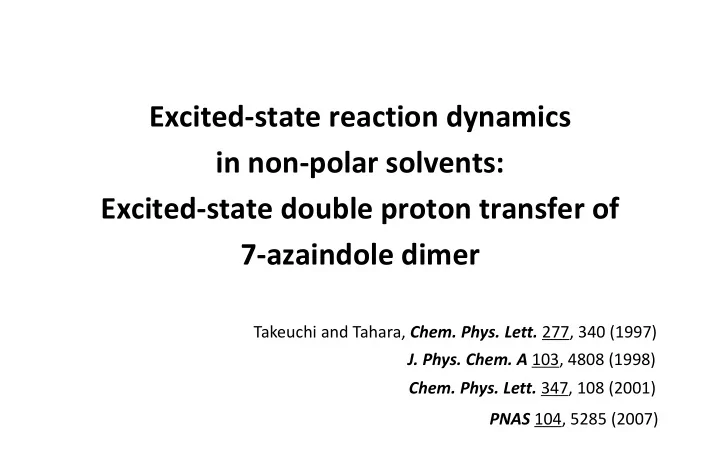

Excited-state reaction dynamics in non-polar solvents: Excited-state double proton transfer of 7-azaindole dimer Takeuchi and Tahara, Chem. Phys. Lett. 277, 340 (1997) J. Phys. Chem. A 103, 4808 (1998) Chem. Phys. Lett. 347, 108 (2001) PNAS 104, 5285 (2007)
7-Azaindole Dimer The Most Famous Model System of the Base Pair
Excited-State Double Proton Transfer of 7-Azaindole Dimer
Absorption and Steady-State Fluorescence Spectra of 7-Azaindole
Femtosecond time-resolved fluorescence of 7-Azaindole dimer 270 nm excitation; 1x 10 -2 M in hexane 0.2 ps 1.1 ps Takeuchi and Tahara, J. Phys. Chem. A , 102, 7740 (1998).
Quantitative Analysis of Time-Resolved Fluorescence ( : fluorescence spectrum in -space 2 k ) k ( v ) k ( ) ( ) i i i ) r k ( d k : radiative decay rate (inverse of radiative lifetime) i i 1 k ( ) d f : oscillator strength i i 2 i
Fluorescence Spectrum of Each Component 1 k ( ) d f i i 2 i oscillator strength
Properties of the Three Fluorescence Components
Fluorescence Anisotropy
Anisotropy Change of Fluorescence from 7-Azaindole Dimer 270 nm excitation; 1x 10 -2 M in hexane
1 L b and 1 L a States of 7-Azaindole It is well known that 7-azaindole (monomer) has two low-lying excited states, 1 L a and 1 L b , which are located closely in energy.
Mechanism of Excited-State Double Proton Transfer Fluorescence Spectra Oscillator Strength Fluorescence Anisotropy Takeuchi and Tahara, Chem. Phys. Lett. 277, 340 (1997). Takeuchi and Tahara, J. Phys. Chem. A 102, 7740 (1998).
A. Douhal, S. K. Kim & A. H. Zewail, Nature , 378, 260 (1995) “We find that the first step occurs on a timescale a few hundred femtoseconds, whereas the second step, to form the full tautomer, is much slower, taking place within several picoseconds.” Femtosecond time-resolved mass spectroscopy in the gas phase (supersonic jet).
A. W. Castleman Jr. (Penn State Univ.) Chem. Phys. Lett. 287, 1 (1998)
Zewail did the experiments also in solution ! J. Chem. Phys. A 102, 669 (1998) J. Chem. Phys. A 103, 7419 (1999)
Mechanism of Excited-State Double Proton Transfer Fluorescence Spectra Oscillator Strength Fluorescence Anisotropy Deuterium Effect
PNAS 96, 8338 (1999) Michael Kasha Nobody can be sure what they observed because ion reactions can occur with ionization or Coulomb explosion!
PNAS 96, 8338 (1999) Michael Kasha For solution, the conclusion of Takeuchi & Tahara is much more trustable!
PNAS 96, 8338 (1999) Michael Kasha NAS Member from 1971 Castleman Jr. NAS Member from 1998
Drastic increase of the number of related paper Web of Science Search by “7 -azaindole dimer” & “double proton Kasha’s PNAS (1999) Castleman Jr .’s PNAS (1999) Zewail’s J. Phys. Chem. A (1999) Tahara’s J. Phys. Chem. A (1998) Zewail’s J. Phys. Chem. A (1998) Tahara’s Phys. Lett. (1997) Zewail’s Nature (1995) Year
Mechanism of Excited-State Double Proton Transfer Fluorescence Spectra Oscillator Strength Fluorescence Anisotropy Deuterium Effect
Excitation Wavelength Dependence
Absorption Spectrum of 7-Azaindole Dimer and Excitation Wavelengths Absorption Spectrum of Dimer (obtained from spectral decomposition)
Excitation-wavelength dependence of the dimer fluorescence decay Detection Wavelength 380 nm 1x 10 -2 M in hexane
Femtosecond fluorescence from 7-azaindole dimer (Red-edge excitation) single exponential!
Excitation-Wavelength Dependence of the Fluorescence Anisotropy Fluorescence wavelength 380 nm
Transition Dipole Moment Directions of 7-Azaindole Dimers The absolute direction of transition moment is taken from the value determined for the monomer in the supersonic jet. A. Nakajima et al.
Excited-State Double Proton Transfer of 7-Azaindole Dimer “The answer to concerted versus step -wise controversy for the double proton transfer mechanism of 7-azaindole dimer in solution” Takeuchi and Tahara, Proc. Natl. Acad. Sci. USA , 104, 5285 (2007)
It was NOT the end ! Kwon and Zewail, PNAS 104, 8703(2007).
S. Take Takeuch uchi i an and d T. Tah ahara, ara, PNAS NAS 104 104, 5285 (2 (2007) Edit ited ed by N. . J. . Turro Approved ved January ry 12, , 2007 Oh Oh-H H Kwo won n an and d A. H. H. Zewa wail, PNAS NAS 104 104, 8703 (2 (2007) Contri Co ributed buted by A. . H. H. Zew ewail ail April il 3, 20 , 2007 J. J. Cat atalan, alan, PNAS NAS 105 105, E78 (2 (2008) Com omme ment nt Oh Oh-H Kwo won an and d A. H. Zewa wail, PNAS NAS 105 105, E79 (2 (2008) Re Repl ply
This was the end ! Oh-H Kwon and A. H. Zewail, PNAS 105, E79 (2008) As we pointed out in our recent publication, another group of researchers stated, “The concerted mechanism, by its definition, does not require such a strict simultaneity, but it only means that the motions of the two protons are correlated”(6). It seems to us that the initial strict definition of concertedness (with the C 2h symmetry path) is softened toward a breakage of C 2h symmetry and asynchronous motion. At the end, it seems not profitable to have in the scientific literature the same claims in different colors, and we hope that this letter will be the epilogue. Reference 6. Takeuchi S, Tahara T (2007), Proc Natl Acad Sci USA 104:5285-5290.
Recommend
More recommend